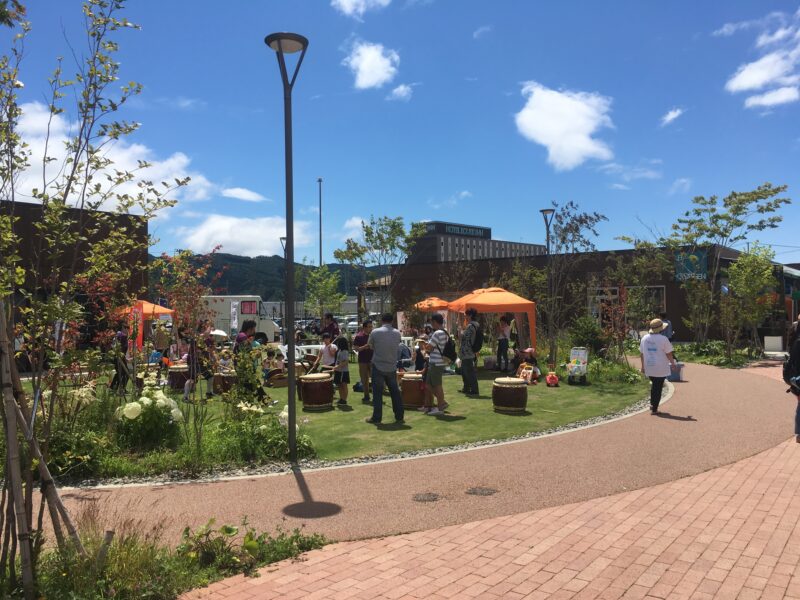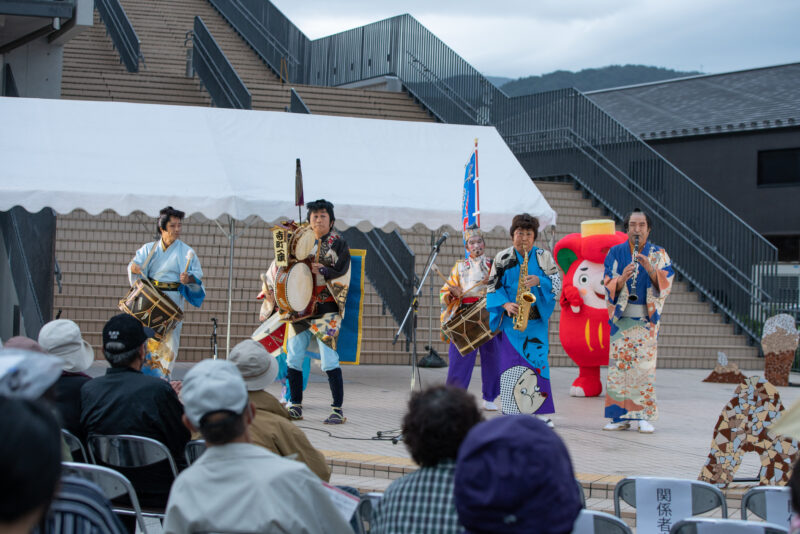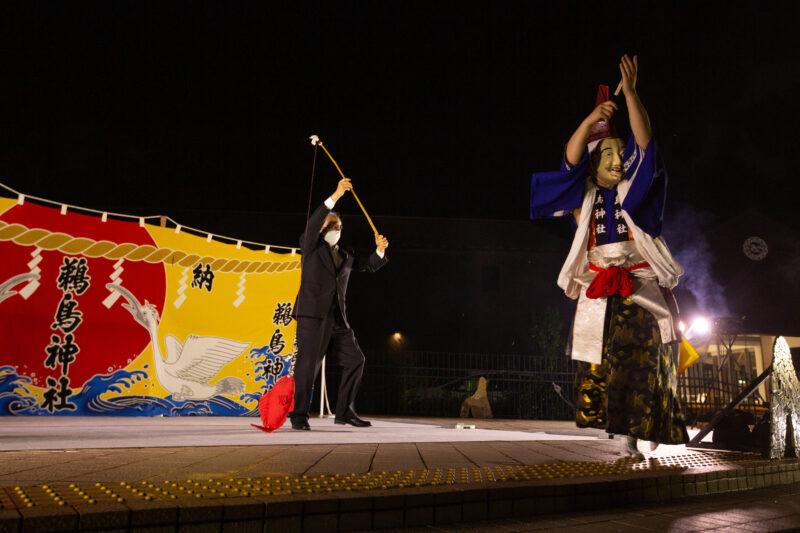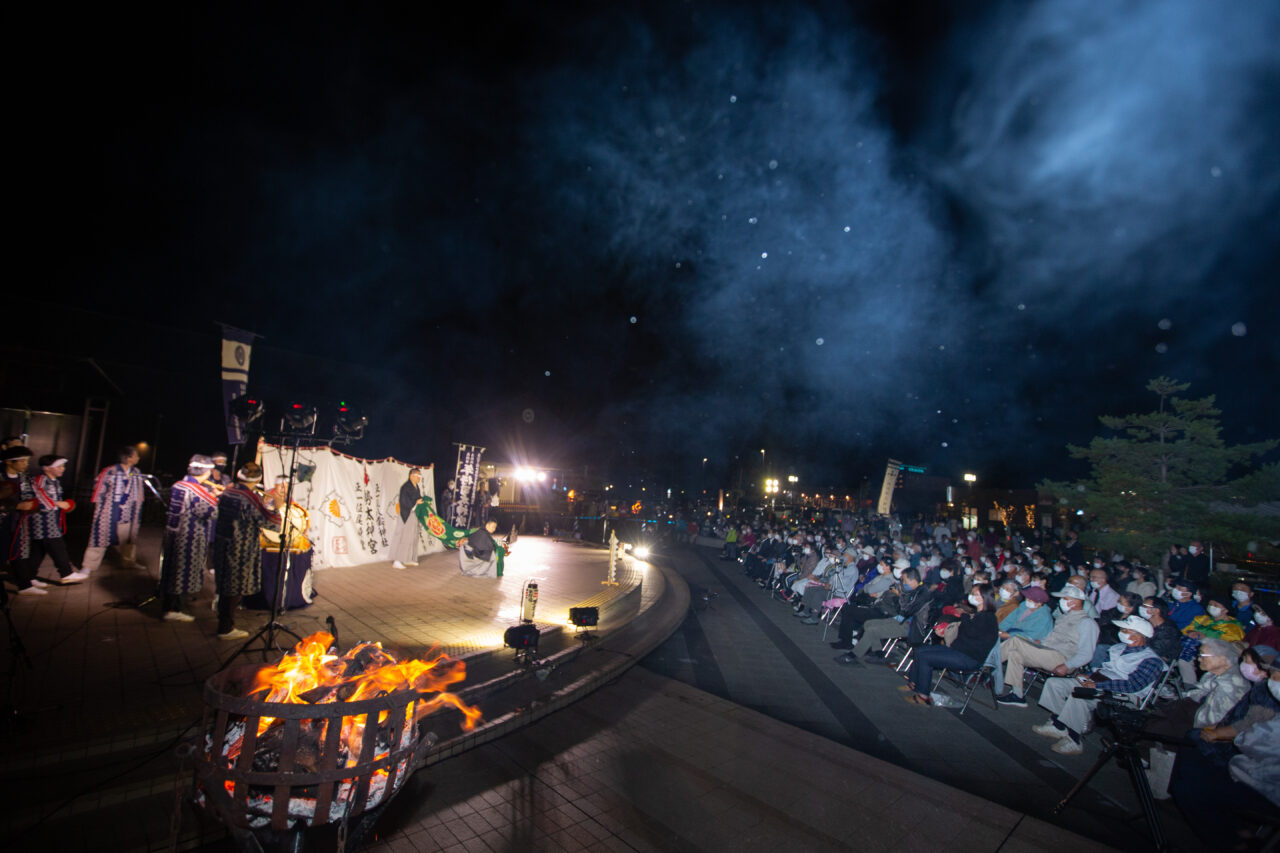CONTENT
SANRIKU INTERNATIONAL ARTS FESTIVAL MODEL TOUR REPORT
- 2022
- suggested-route
- Interact
- Experience
- Appreciation
The Sanriku International Arts Festival 2022 featuring 15 cities and towns along the Sanriku Coast, and stretching over 700 km from Aomori to Iwate Prefectures, is held from September to the following March. The Sanriku International Arts Festival started in 2014 in the coastal areas that were severely damaged by the Great East Japan Earthquake. Today, it attracts various folk performing arts groups and contemporary artists, primarily from all over Asia.
This year, it finally became possible to hold in-person, full-fledged events with the general public after the festivals being held online due to the COVID-19 pandemic. The main event was the Sanriku Kagaribi Bonfire Festival, where Shishiodori(Deer Dance), Nenbutsu Kenbai (Buddhist Chant Sword Dance), Kagura, and Toramai (Tiger Dance) were all performed. The event was held outdoors in front of Ofunato Station for four hours on September 24th. In addition, the Sanriku Future Geinoh Festival, featuring young practitioners of folk performing arts, was held for the first time on September 11th. Children and young people enjoyed sharing dances beyond the difference of their respective styles and forms.
We have created original model itineraries for visitors to fully enjoy Sanriku and its folk performing arts. Through a trip with us along these itineraries that included the Sanriku International Arts Festival, they gained a deeper understanding of Geinoh (folk performing arts) while enjoying the history, culture, and sightseeing of the region. Here are the reports from the participants.
MODEL TOUR REPORT
1 Trip to Encounter Rich and Colorful Folk Performing Arts 3 days / 2 nights Sep. 23 – 25 (Fri, holiday – Sun) Route: From Tokyo to Ichinoseki to Ofunato
2 Trip to Meet Young Practitioners of Folk Performing Arts 3 days / 2 nights Sep. 9 – 11 (Fri – Sun) Route: From Tokyo to Hachinohe to Hirono to Hachinohe to Tokyo
3 Trip to Otsuchi: Meeting the Town of Folk Performing Arts 3 days / 2 nights Oct. 14 – 16 (Fri – Sun) Route: From Tokyo to Morioka to Otsuchi to Morioka to Tokyo
Trip to Encounter Rich and Colorful Folk Performing Arts 3 days and 2 nights
Sep. 23th – 25th (Fri, holiday – Sun)
Route: From Tokyo to Ichinoseki to Ofunato
The folk performing arts of Sanriku came together in the city of Ofunato in Iwate Prefecture in September for the Sanriku Kagaribi Bonfire Festival, presented as part of the Sanriku International Arts Festival. With participation by seven different groups, the event was a celebration of folk performing arts with much to see. It takes two hours by car or four hours using public transportation to get to Ofunato from Morioka. For those coming from afar, we recommended making a weekend trip to Ofunato, and offer a three-day itinerary as a model. Let’s get a taste of the history and folk performing arts of Tohoku with Reibun Suganuma, who is a guide for tourists visiting from Taiwan.
Itinerary for the Model Tour
Day 1 – Friday, September 23rd
| Itinerary | Remarks | |
|---|---|---|
| 08:48 | Depart Tokyo Station for Ichinoseki(11:23) | Tohoku Shinkansen ‘Yamabiko 53’ |
| In Ichinoseki: | ||
| 11:50 | Depart Ichinoseki Station for Chusonji-mae Station(12:12) | (Iwate Prefecture Transportation bound for Ion Maesawa) |
| 12:15 | Chuson-ji Temple Sekinoichi Shuzo Sake Brewery Kyoya Somemono-ten Dye Shop | Explore on foot |
| 15:30 | Depart Ichinoseki Station for Genbikei-mae(15:50) | Iwate Prefecture Transportation Genbikei Line |
| 15:50 | Genbikei Gorge Glass Park | Explore on foot |
| 17:40 | Depart Genbikei-mae Station for Ichinoseki Station(18:01) | Iwate Prefecture Transportation Genbikei Line |
Day 2 – Saturday, September 24th
| Itinerary | Remarks | |
|---|---|---|
| In Ichinoseki | ||
| 10:17 | Depart Ichinoseki Station for Kesennuma Station (11:45) | JR Ofunato Line bound for Kesennuma |
| In Ofunato | ||
| 11:57 | Depart Kesennuma Station for Ofunato Station(13:15) | JR Ofunato Line BRT bound for Sakari |
| 13:30 | Kyassen Ofunato Sanriku Blue Line Project Exhibition Iwate Art Brut Traveling Exhibition 2022 | Explore on foot |
| 16:00 | Sanriku Kagaribi Bonfire Festival at Ofuna-port | Explore on foot |
| 20:30 | Closing Ceremony of the Festival (including tossing free mochi (rice cakes) to the crowd |
Day 3 – Sunday, September 25th
| Itinerary | Remarks | |
|---|---|---|
| In Ofunato | ||
| 09:11 | Depart Ofunato Station for Kisekino Ipponmatsu (Miracle Pine Tree) Station(09:51) | JR Ofunato Line BRT bound for Kesennuma |
| In Rikuzentakata | ||
| 10:00 | Iwate Tsunami Memorial Museum / The Miracle Pine Tree | |
| 12:30 | Depart The Miracle Pine Tree Station for Ofunato Station(13:15) | JR Ofunato Line BRT bound for Sakari |
| In Morioka | ||
| 13:22 | Depart Ofunato Station for Morioka Station(16:31) | Iwate Prefecture Transportation Morioka Line |
| 19:14 | Depart Morioka Station for Tokyo Station(21:23) | Tohoku Shinkansen ‘Hayabusa 44’ |
Day 1 – Friday, September 23th
Enjoy Ichinoseki and Hiraizumi to the fullest
In the morning, we arrived at the City of Ichinoseki, at the southernmost part of Iwate prefecture, ready to enjoy the history and see the sites around the city. Since there are folk performing arts transmitted from Ichinoseki to Ofunato, we wanted to experience and learn the local history and culture of the region to get a sense of the environment which had nurtured the folk performing arts for hundreds of years, before attending the Sanriku Kagaribi Bonfire Festival on the following day.
When it comes to historical site seeing, Chuson-ji temple designated as a World Heritage Site, which has a deep relationship with the Sanriku region’s folk performing arts, tops the list. The temple honors and appeases the spirits who died in battles in the late Heian period. Sword dances seen in Iwate Prefecture that have been handed down to the present day, like Nenbutsu Kenbai (Buddhist chant sword dance) and Yoroi Kenbai (armor sword dance) have their origins in placating the spirits of those who have died here, including Minamoto Yoshitsune. Despite the light rain, it was crowded with men and women of all ages. It is convenient for tourists to visit here as it only takes about 22 minutes by bus from Ichinoseki Station. However, because there are other attractions in the area as well, if it is possible, getting around by a rental car or taxi would make it even more enjoyable.

One of the greatest pleasures of traveling is the local cuisine. Ichinoseki is most famous for its rice cake dishes. Sekinoichi Shuzo, a sake brewery, is a 15-minute walk from the Ichinoseki Station. In addition to sake, they also make beer and cola and serve the fun and tasty treats Kaho mochi and Tenobe (hand-stretched) Hatto at their restaurant. The highly recommended Kahomochi-zen has nine kinds of mochi beautifully plated. Though I was getting quite full, I was having so much fun that I couldn’t stop eating, and before I knew it, I had finished the whole thing! There is also a sake museum and a library on the premises. Visitors can enjoy sake in the quiet courtyard surrounded by historical architecture. It’s a popular place to visit for people from all over Japan and around the world.

We stopped by the Kyoya Somemono-ten, a dyeing shop near the Sekinoichi Brewery where dyeing techniques have been practiced for over 100 years. Today, the young staff members make unique works with their original ideas and make this shop even more attractive. In addition to clothes that combine traditional flavors with contemporary design, the shop offers a variety of crafts made with traditional handicraft techniques. The tenugui (hand towels) supporting local performing arts were especially eye-catching. A portion of the sales from the tenugui towels, which are designed with motifs from the folk performing arts of Iwate, goes to support the traditions suffering from the COVID-19. I not only loved the concept, I loved the designs of these tenugui and decided to buy some right away.

We cannot miss going to Genbikei Gorge, a National Scenic Beauty and Natural Monument in Ichinoseki. I was completely mesmerized by the faraway view and the intricate shapes of the mountains. I definitely wanted to try the famous flying mochi dumpling called Kakkou Dango. When you hit the board with a wooden hammer, a basket with dumplings ‘flies’ across a rope from the other side of the river. It comes with tea, so you can sit down and enjoy it along with the scenery, which makes these treats taste twice as good. Right nearby is Sahara Glass Park, where over 100,000 glass products from Japan and abroad are on display and sold to visitors.
Day 2 – Saturday, September 24
Wishing upon the Sanriku Blue Tiles

On the second day, we headed to Ofunato City for the highlight of this trip, the Sanriku Kagaribi Bonfire Festival. When we arrived at the Ofunato Station on BRT*, we saw the festival staff setting up the station plaza for the event, which was beginning at 4pm. We decided to eat first and walked to Kyassen Ofunato. Built to aid in the recovery from the tsunami caused by the Great East Japan Earthquake, Kyassen is a commercial complex featuring restaurants and shops.
*BRT stands for Bus Rapid Transit system. The railroad for the JR Kesennuma and the JR Ofunato Lines, both destroyed by the Great East Japan Earthquake, have been made into an exclusive route for the BRT buses.
After lunch, we went for a walk to the seawall along the coast. From September 23rd to October 9th, an exhibition was held here of the Sanriku Blue Line Project created by the prefecture’s elementary school students. It’s a blue mosaic work, reflecting the Sanriku sea, conceptualized by visual artist Shinta Inoue. The bright blue color on the seawall can be seen from quite a distance.
Let us never forget that this site was swallowed up by the tsunami on March 11, 2011. People who cared for this region added tiles one by one to complete the mosaic, hoping to connect to the future. The mosaic wall reaches a height of 7.5 meters above sea level, stretching from the ground to the sky like a tree of life. The tiles also depict the height of the tsunami, and illustrate the scale of devastation caused by earthquakes in the past: 1960 Chile Earthquake 5.5 meters; 1896 Meiji Sanriku Earthquake 6.9 meters, and 2011 Great East Japan Earthquake 9.6 meters. With letters made of refreshingly blue mosaic tiles, it speaks to the danger of the tsunami caused by the Great East Japan Earthquake. A series of cubes made of nine square tiles combined like a Rubik’s Cube, are lined up along the seawall for many meters. Not one of them has the same color combination as another, as many children were involved in making them, coming up with their own designs. Each of us has had a different experience of the earthquake’s devastation and has faced it differently. The variety of the colors and combinations remind us that behind the statistics are individuals with different thoughts and personalities.
Works from the Iwate Art Brut Traveling Exhibition 2022 were also on exhibit at this embankment (sea wall), and I felt that various people are connected through the artwork at the wall.

Sanriku Blue Line Project
With the theme of “Communicating, Connecting, Praying,” the Sanriku Blue Line Project connects different parts of the Sanriku coastal region with blue tiles. The project aims to remind people of the Great East Japan Earthquake and the surrounding nature, and to nurture a culture that transcends the region. Visual artist Shinta Inoue organizes “post-workshops,” playgrounds for the expressions of more than 5,000 children annually. He was invited to lead the workshop that made the mosaic with participation from children to adults from the region that includes Ofunato City. The art works were exhibited for a limited time at places of high priority for disaster prevention education, such as along seawalls.
Not only with local residents, but also with tourists visiting Sanriku, the project aims to revitalize the region while memorializing the disaster and cultivating an awareness of nature. As per its theme of “Communicating, Connecting, Praying,” the Sanriku Blue Line Project seeks to connect people’s hearts beyond distance and time, and symbolizes a vision of Sanriku that is cared for, protected, and handed down to generations 1000 years in the future.

Enjoy Various Folk Performing Arts All Together in Ofunato!
At 4:00 PM in the evening, the sound of a chindon-ya street performance group echoed through the air. It was the Chindon Teramachi Ichiza from Ofunato. With their lively rhythms, excitement enveloped the town for the day’s main event.

This event, the Sanriku Kagaribi Bonfire Festival, brings together a variety of local folk performing arts from the Sanriku coastal region. It is said that there are hundreds of different types of folk performing arts in the more than 5,700 square kilometers of coastal area, and because they are widely scattered and deeply rooted in their local communities, they can only be seen by visiting each area. This time however, seven groups from the Sanriku coastal region, including Kagura, Toramai (Tiger Dance), and Shichifukujin (Seven Lucky Gods) performing groups, were brought together, allowing visitors to experience the diverse folk performing arts culture of Sanriku all at once. Bonfires were lit on the outdoor stage, flickering in the sunset. Visitors were given a special treat of Ofunato’s famous confectionery, Kamome no Tamago (Seagull’s Egg), as well as a leaflet with coupons that could be used at nearby stores, which was a nice bonus. We were happily wondering which shop to visit afterwards.
However, as the evening progressed, the weather began to look ominous, and unfortunately, light rain started to fall just around curtain time. Visitors were guided to the nearby Ofuna-port’s piloti to take shelter from the rain. Just as it seemed like the event might have to be canceled, the opening declaration began inside the piloti, as if the excitement and anticipation of the crowd pushed the organizers to do so.
The first group was Sugenokubo Shishiodori / Kenbai from Tanohata Village, Iwate Prefecture. One of the performers said in their greeting, “I feel a sense of achievement to be seen by everyone.” For performing arts groups that could not continue their activities due to the COVID-19 pandemic, the opportunity to showcase their performance in front of an audience is very valuable. The dance was bold and vigorous, the dancers shaking their antlers like wild deer. Shishiodori, the deer dance and Kenbai, the sword dance quickly alternated with each other. The audience surrounding the performers gave a big round of applause.

Next up was the Ushifushi Nenbutsu Kenbai performance group from Miyako City. People of all ages, from children to adults, held their naginata swords high while riding on the beats of drums and flutes. As the performers declared, “Pay special attention to the intense sword fighting scenes,” the duos clashed their blades with great force! The audience surrounded them in a circle, creating with their presence a feverish atmosphere. At one point, a performer became nervous and lost his coordination with the others, but with the support of his seniors, he regained his confidence and completed the performance. It conveyed the continuation of the tradition across generations.

An announcement was made at this point that the next performance would take place on the outdoor stage, which was the original venue. As if signaling the end of the evening shower, a rainbow appeared in the sky.
In the dimming light, a bonfire was lit next to the stage. The faintly visible white mask of the God Ebisu emerged and created a fantastical atmosphere. This was the Fudai Village’s Unotori Kagura. During the scene where Ebisu-sama caught a sea bream, Kimiaki Toda, the Mayor at the time, who was enjoying the show in the front row, was called onto the stage to play the role of catching the fish , to the great delight of the audience.


The Nanbu-han Jushoin Nengyoji Shihai Daikagura from Kamaishi City overwhelmed the audience with the dynamic movements of the Shishimai lion dance. The Lion dancing in the complete darkness seemed as if it were really alive, about to attack at any moment.

The Kita Shichifukujin-mai from Rikuzentakata City has become the main visual of the event. Though it had lost its vitality due to population decline and COVID-19, they were motivated to rebuild after performing the dance at the Sanriku International Arts Festival 2021 the previous year. The dance was originally a ritual by children to pray for a good harvest and a bountiful catch, but this time it was performed by adults. The sight of the seven gods of fortune coming out one after another and dancing in a playful manner was delightful, and the lively rhythm was so pleasant that it lingered for a while afterwards.

The Otsuchi Town Toramai Kyogikai was the only Toramai tiger dance that appeared in the festival. The group showcased a powerful and impressive dance. Two tigers leaped and ran about the stage, and when they opened their gaping mouths towards the audience, the crowd cheered in excitement.

The last to perform was a local group, the Gyozan-ryu Sasazaki Shishiodori from Ofunato City. Cheers were heard from the audience even before the start of the performance. Each dancer carried a pair of 2.8-meter-long bamboo sticks called sasara on their backs, and their rhythmic footwork to the beat of the drums was reminiscent of a herd of deer running through the fields and mountains. The lively and agile dancers formed a circle, becoming eight deer that then twirled around, greatly heightening the climax of the performance.
Then, after nearly five hours, amidst the festive atmosphere of the ritual tossing of red and white mochi rice cakes for the crowd, the Sanriku Kagaribi Bonfire Festival came to a close.

Sanriku Kagaribi Bonfire Festival
Date: Saturday, September 24, 2022, 16:30-21:00
Venue: Ofuna-port and the Plaza in Ofunato City, Iwate Prefecture
In a showcase of the many different folk performing arts that exist along the Sanriku Coast, seven vibrant groups come together to perform under bonfire light. This festival is an opportunity to enjoy the folk performances from as far north as Fudai Village to as far south as Rikuzentakata City in Iwate Prefecture all at once. The venue also hosts screenings of rare footage of Javanese dance from Indonesia, with whom the local artists have had a long-term artistic exchange at this festival. The various folk performing arts have been passed down from ancient times and continue to thrive in Sanriku. They are a unique form, deeply rooted in people’s lives and serving as a prayer for abundant harvests by farmers, as well as for calming the spirits and making dedications to the gods. They are a one-of-a-kind art that is cherished and taught to each generation with great care. It is one of the cultural offerings that Japan most proudly presents to the world.

Day 3 – Sunday, September 25
A Day to Remember the Earthquake Disaster

On the last day, we took the BRT to Kisekino Ipponmatsu (Miracle Pine Tree) Station in Rikuzentakata City. The brand new building in front of the station is the Iwate TSUNAMI Memorial Museum, which opened in September 2019. It displays a vast collection of records about the tsunami and earthquakes, including historical resources, records of the disaster, how the victims felt and behaved during that time, how the government and support organizations responded. It also showcases the achievements and evaluations of those efforts and the voices that have been heard from all over the country. Some exhibits make it easy to imagine what specific actions should be taken if we were ever to be affected by a disaster in the future. The exhibition is filled with a strong desire to never repeat this sadness again.

From the Iwate TSUNAMI Memorial Museum, a road stretches straight south. When we climbed the stairs at the end of the road, we finally saw the sea spreading out before us. Flowers were offered towards the sea, and to the right stood the Miracle Pine Tree that withstood the tsunami. Even on this day with light rain, several people came and went, quietly watching the sea along the coast, the rain quietly drowning out various sounds. I recall that it was snowing on “that day” too.
And so, our trip to Ofunato, filled with site-seeing, folk performing arts, and remembrance of the earthquake disaster, came to an end. It was a 2-night, 3-day journey of watching folk performing arts gathered from various places in Sanriku, an experience made even more profound by learning about the historical footprints on the land, such as the world heritage sites and the traces of the tsunami.
The Tour Reporter’s Comments

from Taiwan, a resident of Japan
Japan receives many tourists from Taiwan, who visit big cities and other destinations. However, to me, cities all look alike. On the other hand, in Sanriku, you can enjoy a unique culture and quietly spend time, which gives you a sense of really visiting Japan. Watching the various folk performing arts of Sanriku up close during the Sanriku Kagaribi Bonfire Festival brought a new sense of value to my travels, as I was able to experience Japan’s traditional culture firsthand. Unlike watching modern stage productions, the dances and accompanying music performed by local performers under the flickering bonfire at dusk became mystical, giving me a direct connection to the traditional folk performing arts that have been passed down from generation to generation in the Sanriku region from ancient times. This alone convinced me that a visit to Ofunato is worthwhile. The number of international tourists has not yet recovered due to the ongoing COVID-19 pandemic, but if there were more events like the Sanriku Kagaribi Bonfire Festival, an event that stands out from others in inbound tourism, it would be very attractive to people abroad.
2 Trip to Meet Young Practitioners of Folk Performing Arts 3 days / 2 nights Sep. 9 – 11 (Fri – Sun) Route: From Tokyo to Hachinohe to Hirono to Hachinohe to Tokyo
3 Trip to Otsuchi: Meeting the Town of Folk Performing Arts 3 days / 2 nights Oct. 14 – 16 (Fri – Sun) Route: From Tokyo to Morioka to Otsuchi to Morioka to Tokyo